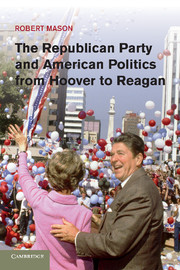Book contents
- Frontmatter
- Contents
- Acknowledgments
- Introduction
- 1 “From Old Home Melodies to Jazz Music”: 1928–1933
- 2 “As Maine Goes, So Goes Vermont”: 1933–1939
- 3 “The Simple Barefoot Wall Street Lawyer”: 1939–1945
- 4 “Liberty versus Socialism”: 1945–1953
- 5 “Modern Republicanism”: 1953–1961
- 6 “A Choice, Not an Echo”: 1960–1968
- 7 “There’s a Realignment Going On”: 1968–1976
- 8 “You Are Witnessing the Great Realignment”: 1977–1989
- Conclusion
- Archival Sources
- Index
- References
2 - “As Maine Goes, So Goes Vermont”: 1933–1939
Published online by Cambridge University Press: 05 December 2011
- Frontmatter
- Contents
- Acknowledgments
- Introduction
- 1 “From Old Home Melodies to Jazz Music”: 1928–1933
- 2 “As Maine Goes, So Goes Vermont”: 1933–1939
- 3 “The Simple Barefoot Wall Street Lawyer”: 1939–1945
- 4 “Liberty versus Socialism”: 1945–1953
- 5 “Modern Republicanism”: 1953–1961
- 6 “A Choice, Not an Echo”: 1960–1968
- 7 “There’s a Realignment Going On”: 1968–1976
- 8 “You Are Witnessing the Great Realignment”: 1977–1989
- Conclusion
- Archival Sources
- Index
- References
Summary
The New Deal produced a sustained period of electoral disaster for the Republican Party. In the Roosevelt administration’s first major test at the polls, in 1934, Democrats confounded normal expectations of a midterm slump for the White House party by making gains, leaving Republicans with only 25 U.S. senators, 103 representatives in the House, and 7 governors. The 1936 elections then offered further disappointments. Alfred M. Landon, Kansas’s governor and one of the few 1934 victors, suffered a resounding defeat in the presidential contest, winning fewer than seventeen million votes to Franklin Roosevelt’s total of more than twenty-seven million. The Republican share of the electoral college dwindled to a northern New England rump of just two states – Maine and Vermont. Republican representation on Capitol Hill declined still further – to sixteen in the Senate and eighty-nine in the House. These devastating results caused some to wonder whether the party had any future at all.
The future looked brighter before long. Frustrations with Roosevelt’s second term allowed Republicans to win back some of these losses in 1938, picking up eight Senate seats, eighty-one House seats, and thirteen governorships. These gains were substantial but fell far short of Democratic totals, thus confirming the GOP’s status as the nation’s minority; even a good year was not good enough. Still, the gains rekindled optimism in the party. Many Republicans started to conclude that public opinion was moving in favor of their argument that the New Deal was a flawed approach to government. In fact, this qualified comeback for the party was the product of voter frustration with the New Deal’s flawed execution; it did not mark a rejection of New Deal principles. Republican optimism was therefore sometimes a misinterpretation of the midterms’ meaning.
- Type
- Chapter
- Information
- Publisher: Cambridge University PressPrint publication year: 2011



